Miniskirts don’t rape, depraved men do!

Ruth Butaumocho Gender Forum
In November last year, hundreds of women in Kenya held a series of demonstrations in protest after a group of men tore off a woman’s clothing for wearing a miniskirt.
The demonstrations received wide coverage around the region and the globe with feminists and activists organising similar demos in solidarity with their Kenyan sister for such brazen attitude from the group of men.
As the information cascaded to this region, the majority of people were naturally shocked, but never imagined in their wildest thoughts that a similar occurrence would happen in our own backyard.
So when a young woman was stripped by a group of touts at the Fourth Street bus terminus last month in full view of everyone, there was an outcry, triggering public demonstrations and a frenzy on social media.
The incident triggered lots of debate around the issue of women, sexuality, crime, dressing and the aspersion that the majority of Zimbabwean men have always had about how women dress in the country.
Rather than regard it as mere apparel women don to protect themselves from weather conditions and to look good, the issue of dressing has in the last few years taken a different dimension with some sections of society dragging it on the centre, as the major reason for the sexual abuse of women.
Through their actions, the touts bought in the dressing debacle as the main reason for women’s abuse, joining in the long list of men who have taken offence at what women wear throughout independent Africa for decades.
The late Hastings Kamuzu Banda’s Malawi banned the same skirt and frowned at women wearing trousers back in the days, arguing that the dressing was provocative.
Even Uganda’s Idi Amin did not like that particular dress either.
Closer to home is Swaziland, which in 2012 banned mini-skirts and crop-tops, saying “they encouraged rape”. Ironically, they did not ban the “indlamu costume”, a tiny beaded belt worn by young women during the annual reed dance.
I had never felt the need to comment on the miniskirt debate before, but it has since dawned on me that it is an issue that should not be overlooked.
If anything, the miniskirt issue has nothing to do with dressing per se.
It is not about how short, long, skimpy or revealing the skirt is, or how it should be worn and in what measures.
The miniskirt debacle really is symbolic of the continuous sexual abuse women face, the power dynamics between women and men and the shrinking safe zones women used to enjoy.
Far from being an issue of dressing, it has also reignited the long-running debate about where sexual crimes begin – with the criminals or with the victims because of what they are wearing?
When the touts ravaged the poor girl in broad daylight, they were insinuating that women will continue to be abused as long as they continue to dress to “provoke and excite men”.
They were ferociously advocating the abuse of all women who choose to dress liberally, further reinforcing the stereotype and the notion that society has always held, that women do invite abuse on themselves through their dressing.
If sexual crimes begin with the victims because of what they are wearing, why are babies in diapers being raped, female members of the apostolic sect donning long garments, disabled women in wheelchairs and grannies, who have nothing to show and cannot be described as symbols of beauty being raped on a daily basis?
Is it not sad that when an incident of sexual assault happens, the first questions that the media or the law enforcers asks are about the victim’s sobriety, or clothes or sexuality, instead of confronting the problem as it is?
While it is important to ensure that both men and women maintain their dignity through their interactions, dressing and association, it is unacceptable and outrageous thinking for people to blame inanimate objects for their sins. Guns don’t kill, people do, miniskirts don’t rape, people do.
That kind of attitude and thinking of blaming victims of sexual assault because of their dressing insults victims of rape, while encouraging perpetrators to wantonly abuse women.







Comments